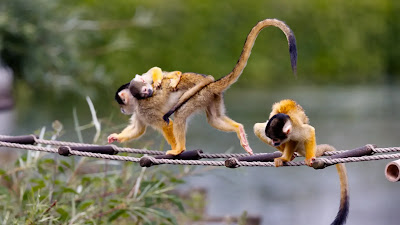Monkey History: An Evolutionary Journey
Monkey History: An Evolutionary Journey
Monkeys are one of the most fascinating creatures on the planet. From their evolution to their behavior and habitat, there is so much to explore about these primates. In this article, we will delve into the history of monkeys, exploring their evolutionary journey from their origins to their current state.
The Origins of Monkeys
The history of monkeys dates back to over 40 million years ago, during the Eocene epoch. It is believed that monkeys first appeared in Africa and later spread to other parts of the world. The earliest monkey-like primates were small, arboreal creatures with long tails and forward-facing eyes, similar to modern-day lemurs and tarsiers.
The Evolution of Monkeys
As primates evolved, so did monkeys. They adapted to their environments, developing different physical and behavioral traits to thrive in various habitats. There are two major types of monkeys - Old World monkeys and New World monkeys.
Old World Monkeys
Old World monkeys are native to Africa and Asia. They are known for their downward-facing nostrils and non-prehensile tails, which cannot grasp objects. They are also more terrestrial than their New World counterparts and are known for their complex social structures.
New World Monkeys
New World monkeys are native to Central and South America. They are known for their prehensile tails, which can grasp objects, and their upward-facing nostrils. They are also more arboreal than Old World monkeys and have a more simple social structure.
Monkey Behavior
Monkeys are social creatures and have complex social structures. They live in groups, ranging from a few individuals to over a hundred. Within these groups, there is a hierarchical structure, with dominant individuals having more access to resources and mating opportunities.
Communication
Monkeys use a variety of methods to communicate with each other. These include vocalizations, facial expressions, and body language. They have also been observed using tools, such as using sticks to extract insects from trees.
Habitat and Diet
Monkeys can be found in a variety of habitats, from tropical rainforests to deserts. They are omnivores, meaning they eat both plants and animals. Their diet varies depending on their habitat, with some species being primarily herbivorous, while others are primarily carnivorous.
Monkey Conservation
Due to habitat loss and hunting, many monkey species are endangered. Conservation efforts are underway to protect these animals and their habitats. Zoos and other wildlife organizations also play a crucial role in educating the public about these animals and their conservation needs.
Conclusion
From their origins over 40 million years ago to their current state, monkeys have evolved to adapt to their environments, developed complex social structures, and faced numerous challenges, including habitat loss and hunting. Understanding the history and behavior of monkeys is crucial to ensuring their survival in the future. Read more
FAQs
What is the oldest monkey species?
The oldest monkey species is believed to be the Propliopithecus from the Oligocene epoch, over 30 million years ago.
How many species of monkeys are there?
There are over 260 species of monkeys.
What is the difference between Old World and New World monkeys?
Old World monkeys are native to Africa and Asia, while New World monkeys are native to Central and South America. They have different physical and behavioral traits to adapt to their habitats.
Why are monkeys endangered?
Monkeys are endangered due to habitat loss and hunting.
The history of monkeys dates back to over 40 million years ago, during the Eocene epoch. It is believed that monkeys first appeared in Africa and later spread to other parts of the world. The earliest monkey-like primates were small, arboreal creatures with long tails and forward-facing eyes, similar to modern-day lemurs and tarsiers.
The Evolution of Monkeys
As primates evolved, so did monkeys. They adapted to their environments, developing different physical and behavioral traits to thrive in various habitats. There are two major types of monkeys - Old World monkeys and New World monkeys.
Read more..
https://xpshort.com/elo2

Comments
Post a Comment